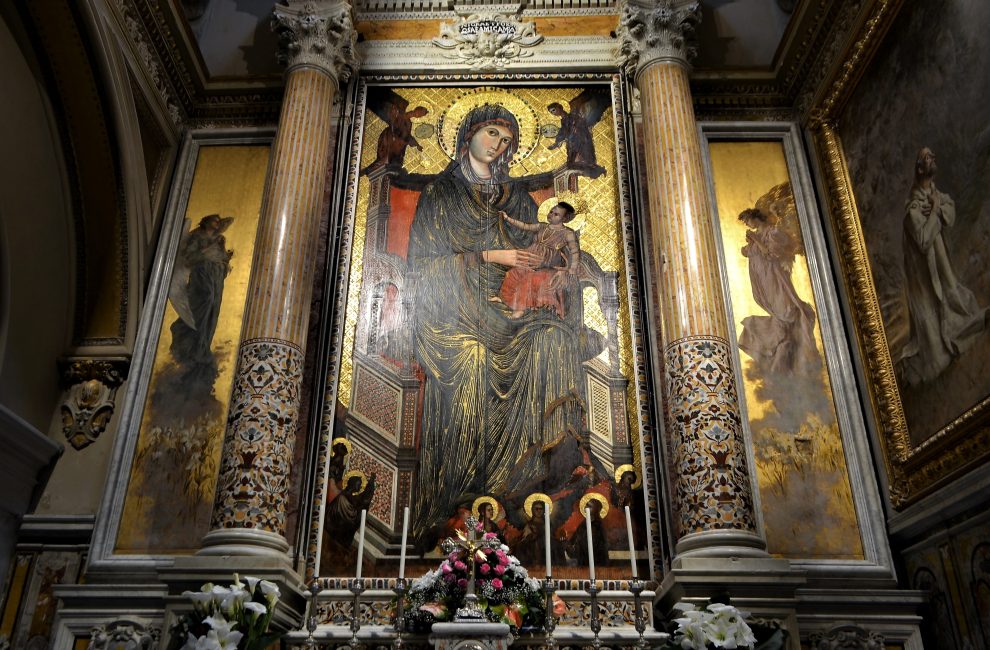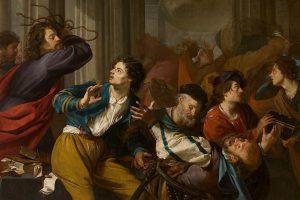On a brisk winter day in the Kingdom of Sicily, around the year 1250, two young men made a journey to the Shrine of Montevergine. The local villagers, seeing the young men holding hands and kissing as they walked to the shrine, became enraged. They attacked the men, stripped them, and tied them to a tree deep in the forests of Mount Partenio. Left to die of frostbite or be torn apart by wolves, ice gathering on their shivering bodies, the men prayed to Mary to save them. According to legend, Mary saw their love for one another and had compassion on them. She freed them from their bonds and sent a ray of brilliant sunlight to melt the layers of snow and ice that enclosed them. The pair rushed into the village, testifying to Mary’s love and compassion. As writer Lura Filios writes, Mary’s act was seen as a “sign of supernatural tolerance.”
Many LGBTQ+ Catholics today still have reason to worry about their safety, just as the two same-sex lovers did in the thirteenth century. In the twenty-first century, as anti-LGBTQ laws, imprisonment, and death penalties proliferate around the world, some members of the LGBTQ+ community turn to the Catholic Church for spiritual need and support. Unfortunately, they are often met with further homophobia, as well as rhetoric that tells them God does not approve of them and will not save them. This is why, for many LGBTQ+ Catholics around the world, the story of Mary protecting and saving queer people, claiming them as her own children, is vitally important. The Madonna of Montevergine, as she became known, is also synonymous with a miraculous icon that represents Mary as a mother who welcomes queer Catholics, affirming that they are created in the same image as her son.
The recent start of the final phase of the Synod on Synodality, where members of the Ordinary General Assembly will discuss LGBTQ+ acceptance and belonging within the church, seems like an appropriate occasion to return to the legendary story, sanctuary, and icon that has come to embody queer Catholic acceptance.
To tell the entire story of the Sanctuary of Montevergine and the icon it would later hold, we must go back to the sanctuary’s founding. It began as a hermitage built by St. William of Vercelli in 1119; over the next few years, other men, seeking to devote their lives to God, asked if they could join William at Montevergine. By the end of the twelfth century, the hermitage had become a conventional Benedictine community.
Shortly afterward, the sanctuary came to house a small panel portraying the Madonna breastfeeding Jesus, with St. William kneeling at her feet; the painting was called the “Madonna of St. William.” As was common with other monasteries, the icon became the heart of the sacred space for people to encounter and reflect on Mary. This was the icon the two young men were on their way to venerate when the mob attacked them.
Some fifty years after the miracle of Montevergine, however, the Madonna of St. William was replaced with a different icon. Now known as the Madonna of Montevergine, this icon is rumored to be much older than the sanctuary. According to legend, this image features a face that St. Luke the Evangelist painted on pine wood; it is believed to be the first of the many Black Madonnas he painted during his lifetime. Eudocia, the wife of the Byzantine Emperor Theodosius II, brought the icon from Antioch to Constantinople and commissioned a whole-body portrait to go with it. During the fall of Constantinople in 1261, Italian tradition states that the last emperor removed the icon’s face. It later reappeared in the collection of Catherine II of Valois, who ordered the face retrofitted into a new full-body icon.
In 1310, Catherine II, then Empress of Constantinople and wife of Philipp II of Anjou, gifted this new icon to the sanctuary in Montevergine. Known among Neapolitans as “Mamma Schiavona”—“Slave Mama” or “Slavic Mama”—because of her skin color, the icon is paraded through the streets of Montevergine every Candlemas, commemorating the purification of Mary and the presentation of Jesus at the temple.
As a Black Madonna, the icon reflects a subset of Marian depictions that portray her with dark brown or black skin; around the world, there are at least 450 images of a dark-skinned Mary. Black Madonnas, some scholars argue, started out pale but age and the smoky accumulation from candles, incense, and oil lamps darkened them; other, more recent scholars, however, believe the Black Madonna’s deepest roots lie in Africa, while still others suggest that if St. Luke was indeed the creator of many Black Madonnas, he may have been portraying Mary’s actual appearance as a Near Eastern woman. In any case, the Black skin subverts expectations that the Madonna is white, and instead cements this Madonna as the matron of people of color and marginalized communities, including queer communities that have faced persecution for millennia.
The figure of Mary herself also already unsettles gender expectations. Mary brought God—who cannot be defined by human concepts like gender—into the world, without the help of any male. By holding divinity within her own female body, Mary becomes queer; in other words, she is outside the traditional expectations regarding gender. So it is fitting that this particular Black Madonna, which came to reside on the site of a miracle offered for queer people, became an icon of divine queer acceptance in the Catholic Church. The icon’s pontifical coronation on May 14, 1712, authorized by Pope Clement XI, may very well be the first church-wide LGBTQ+ celebration, venerating a Madonna who recognizes and champions LGBTQ+ Catholics. “Her adherents describe her as the one who ‘gives everything, forgives everything,’ ” writer Danielle Oteri notes.
Queer Catholics and other queer people of faith, especially those who have been abused and abandoned by the church, continue to pray to and meditate on Mother Mary. In fact, two years ago, Michael Thérèse McQueen developed the Five Mysteries of the Queer Madonna, inviting people praying the rosary to reflect on the miracles this Madonna performed to protect and love her LGBTQ+ children. These mysteries invite prayerful reflection on the story of Montevergine, from the Madonna’s ancient roots to Mary’s miracle to her icon’s festive presentation each year in celebration of Mary’s return to the temple.
As McQueen explains, the Madonna of Montevergine “rejoices in the diversity of gender and sexuality of her children.” Today, Catholics continue to meditate on and pray to the proud and ancient Madonna who has never stopped fighting for their right to life and love.
Image: Wikimedia Commons














Add comment